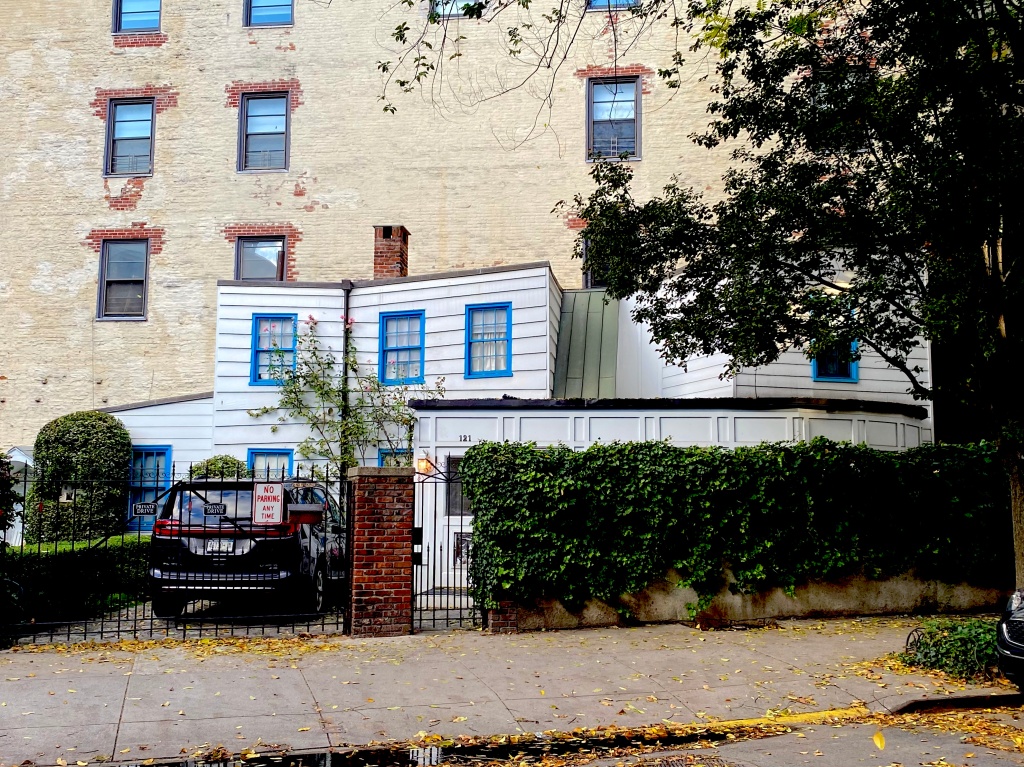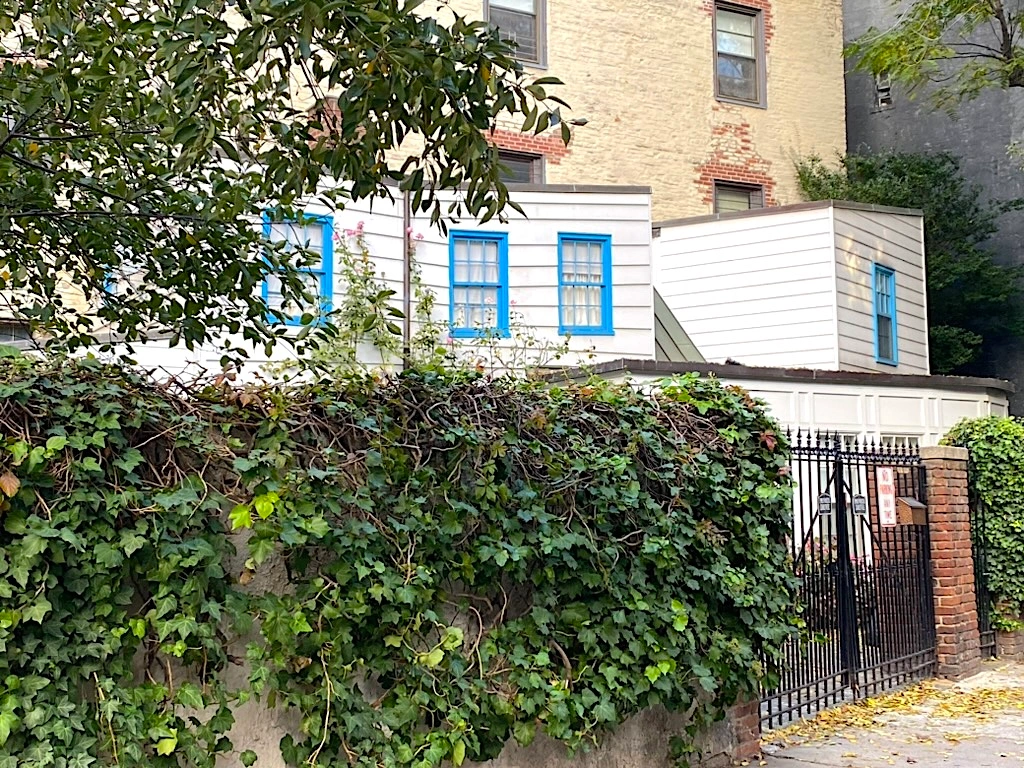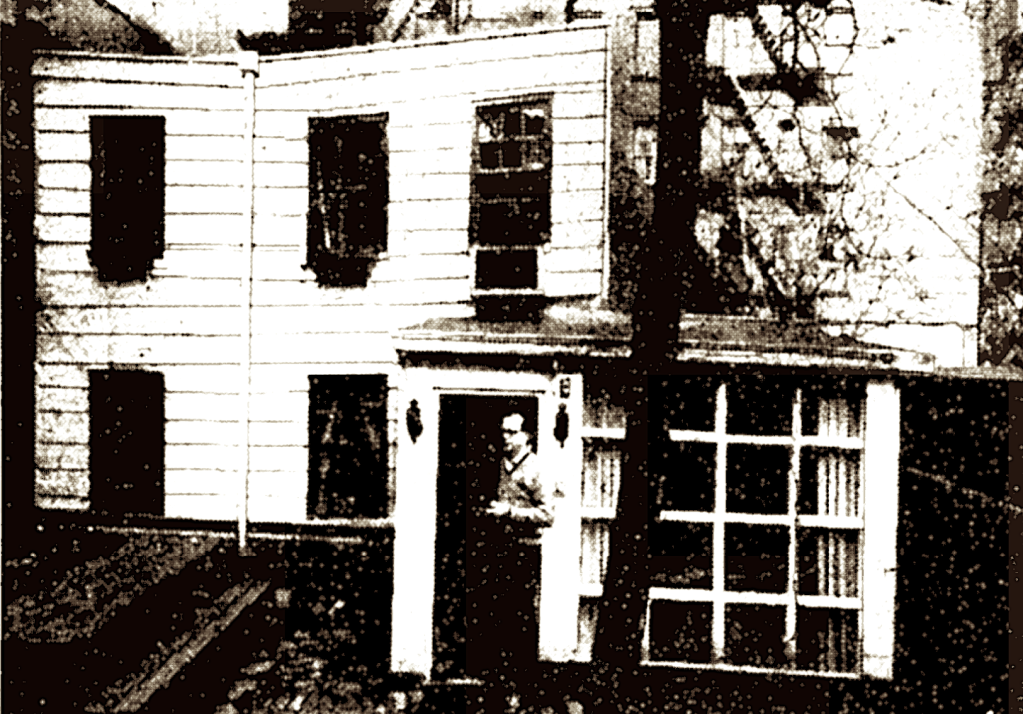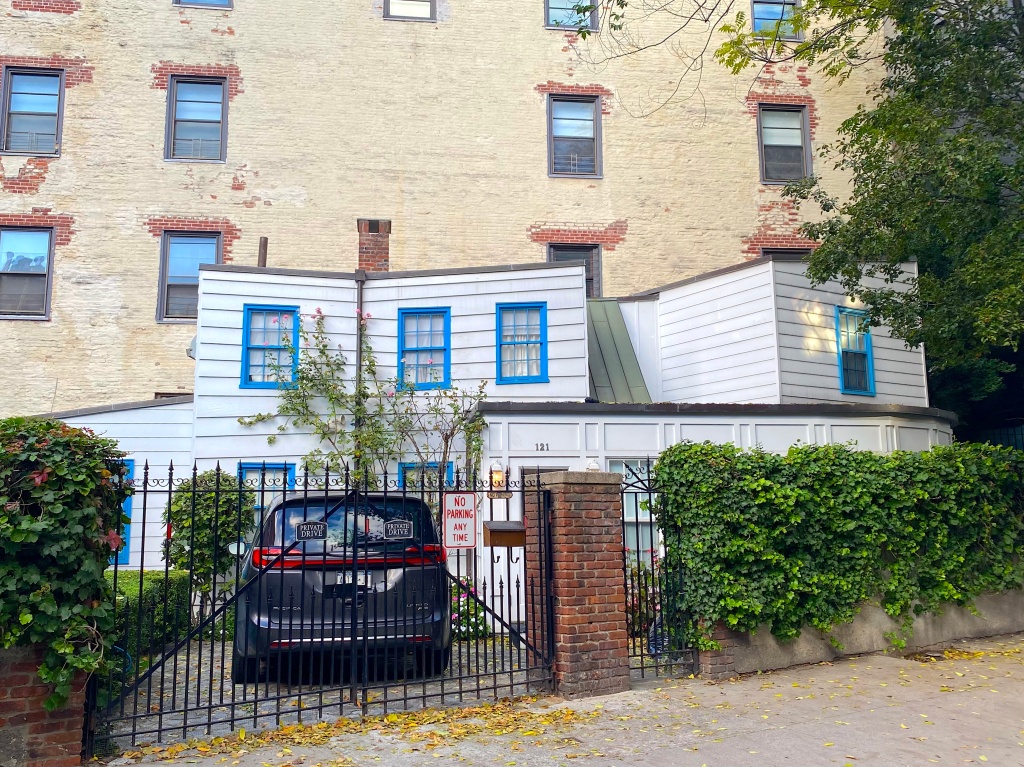The West Village is rich with historic houses—especially diminutive Federal-style survivors from the early 19th century and elegant brownstone rows constructed before and after the Civil War.
But this modest white clapboard farmhouse on Charles and Greenwich Streets might be the most intriguing of all. Every day, it attracts curious views from passersby—who peer through its iron fence and peek over the thick ivy walls to catch a glimpse of the antebellum city on a quiet West Village corner.
Dwarfed by its tall tenement neighbor, the tidy farmhouse (with a suburban-style driveway) resembles something out of a storybook: three small sections that kind of unfold like a book, two short stories, one slender brick chimney, and a roof that looks, well, a bit askew.
This New York relic has been at 121 Charles Street for more than 50 years, and its dollhouse-like presence delights and puzzles newer generations of West Villagers.
But like so many Village mysteries, the farmhouse has a fascinating backstory. This one began miles away in the Manhattan countryside and involves urban redevelopment, renters unwilling to part with of a beloved home, and a flatbed truck.
The farmhouse’s journey started in Yorkville roughly 200 years ago. At the time, Yorkville was a bucolic part of Manhattan dotted with farms and estate houses by the East River—connected to the main city only by the Boston Post Road (about today’s Third Avenue) and stage lines.
In this remote enclave, someone built the little farmhouse, putting in small paned windows and a staircase outside that connected the two floors, per a description from a 1966 New York Times article. Its location corresponded to today’s York Avenue between 71st and 72nd Streets.
Exactly when it went up isn’t known. “Saw marks found on the wood indicate that it was built after the introduction of saw mills, which would date the house to the early 19th century at the earliest,” states a post on Off the Grid, part of the website of historic preservation group Village Preservation.
In the 1860s, as Yorkville began losing its rural feel, the farmhouse was purchased by a man named William Glass, who with his wife ran a dairy inside.
The couple also built a two-story house in front of the farmhouse, 1335 York Avenue, thereby blocking it from view from the street. “The property became known as Cobble Court because of the cobblestones that paved the area between the two houses,” notes Village Preservation.
After spending time as a restaurant in the early 20th century, the farmhouse became a residential rental. In the 1940s, children’s book author Margaret Wise Brown (above, in a Life magazine photo) became the latest occupant. Perhaps living in a farmhouse walled behind another house helped inspire her most famous book, 1947’s Goodnight Moon.
In the 1960s, a man named Sven Bernhard (below), and later his wife, Ingrid, made their home in the farmhouse. “Time and various tenancies had dealt harshly with the two-story clapboard dwelling, and when Mr. Bernhard moved into it in 1960 it was virtually uninhabitable,” wrote Thomas W. Ennis in the 1966 New York Times article on this newly rediscovered “hidden house.”
“From 1960 to 1963, Mr. Bernhard, working alone, rehabilitated the dwelling, for which he is paying $65 in rent,” continued the 1966 Times article. The outside staircase was enclosed, per the article, and Bernhard added a glass porch.
This is where urban redevelopment makes its appearance. The Archdiocese of New York City now owned the farmhouse; it had been sold to them by descendants of the Glass family. The Archdiocese planned to raze a row of houses on York Avenue, including Number 1335 and the farmhouse behind it, to build the Mary Manning Walsh Home for the Aged.
“Still renters but unwilling to give up their beloved house, the Bernhards went to court and eventually won ownership around July 1966,” states Village Preservation. They had six months, until January 31, 1967, to move it elsewhere.” The lot at Charles and Greenwich Streets was found and secured.
After much bureaucratic wrangling with permits and permissions, the move took place in March 1967 (above). “The cobbles from the York Avenue site were brought here to recreate Cobble Court,” adds Village Preservation.
The Bernards stayed in their farmhouse until 1986. In 2001, another owner—who told The New York Times in a 2008 article that she’d “pined for the house” since she was a child in the late 1960s, when she “spotted it from the back of her parents’ station wagon”—took on a renovation. About 500 square feet was added, cedar planking restored, and new electric and plumbing put in.
In 2014, the farmhouse had a brush with potential demolition when the house was briefly put up for sale for $20 million. These days, this securely landmarked anachronism of rural New York City seems to have found its forever home.
[Fourth photo: Life magazine via Literary Hub; fifth photo: New York Times; sixth photo: Jack Manning/New York Times via Village Preservation]
Tags: 121 Charles Street Cobble Court, 121 Charles Street Farmhouse, 1335 York Avenue Farmhouse NYC, Farmhouse Charles Street West Village, Margaret Wise Brown Farmhouse New York City, Oldest Houses in West Village, Story of 121 Charles Street Historic Farmhouse, Wood Farmhouse West Village 1820s







October 23, 2023 at 4:49 am |
In the late 1990’s I lives on far west Canal Street and passed this house all the time walking or biking or driving up Greenwich Street. During that period I photographed and wrote and article on various urban birdhouses I’d encountered for the Times. This little house had a littler birdhouse , modeled on it, visible from Charles Street. I briefly met the owner who told me that they had moved the house from uptown and that it had been a “building in the back” that one occasionally finds in Manhattan. Your research fills out the story. Thanks
October 23, 2023 at 11:55 am |
You’re welcome, and I think I saw that birdhouse in the yard but was unable to get a decent photo of it.
October 23, 2023 at 4:49 am |
Thank you! I have always loved what I’ve called The Little House since childhood! The land value alone would make it well beyond my means, and I’ve worried that some developer would knock it down. I hope that ‘secure landmark status’ preserves it for my grandchildren to dream on.
October 23, 2023 at 6:43 am |
I pass it often.
October 23, 2023 at 6:44 am |
This was my family’s house. My grandfather grew up in the house. He told me many stories about the house and what it was like to live in it, though he spent most of the time in the house they built in front of it.
October 23, 2023 at 11:56 am |
Your family has a long history in New York City! I’d love to know what he recalls growing up in this little piece of the early 19th century.
October 24, 2023 at 9:23 am
My Great Aunt operated a small restaurant out of there for a short period of time. You had to walk through the house built in front of it to get to the courtyard. I have some pictures of the menu I can try and send to you. Not sure if I can post pics here.
there is also a nice write up about the renovations and expansions that were done in the June 2003 issue of This Old House magazine. Lots of nice pics.
October 23, 2023 at 7:50 am |
The house is included on page 80 of “HOLDOUTS!: The Buildings That Got In The Way.”
October 24, 2023 at 12:30 am |
It’s one of my favorite holdouts, with an unusual story. I can’t think of any other holdout house that was trucked to a new neighborhood in Manhattan.
October 23, 2023 at 8:09 am |
Very interesting article. Nice to know they’re ared people still fighting to preserve history. Unlike Los Angeles. And the photo from 1967 by Jack Manning. I wonder if that was the NY based actor who appeared in many Broadway shows at the time.
October 23, 2023 at 8:25 am |
Lovely story, thanks!
October 23, 2023 at 8:29 am |
The house had a very famous occupant in the early decades of the 20th century: https://newyorkwanderer.com/mister-dog/
October 23, 2023 at 11:06 am |
How beautiful! Thanks for sharing.
October 24, 2023 at 12:33 am |
Yes, thanks Ben for sending the link! It helps add to the story of this wonderful little farmhouse.
October 23, 2023 at 9:11 am |
Speaking of “Holdouts” this appeared in my feed today: (3rd and 75th) https://gothamist.com/news/a-manhattan-dilemma-is-decent-rent-worth-living-in-a-construction-zone?
October 23, 2023 at 11:57 am |
Ah yes, I passed that tenement several weeks ago and am working on a post about it and similar holdouts. Stay tuned!
October 23, 2023 at 4:02 pm
It’s not a tenement, it’s a co-op.
October 24, 2023 at 12:34 am
The white building? It might be a coop, but it’s a tenement-style building.
October 23, 2023 at 9:24 am |
I love that it has survived all of this
October 23, 2023 at 9:46 am |
When was it landmarked?
October 24, 2023 at 11:49 pm |
In 1969, along with the entire Greenwich Village Historic District. The house had moved to Charles Street two years earlier.
October 25, 2023 at 1:33 pm
Interesting, thanks. How could it have had a brush with potential demolition in 2014 if it was landmarked then?
October 29, 2023 at 11:06 pm
Apparently the owner put it up for sale and listed it as a “potential development site.” That immediately raised the eyebrows of local preservationists, who noted that any changes to the house had to be approved by the Landmarks Preservation Commission, as the house falls within a historic landmarked neighborhood. My understanding is that the owner then took it off the market.
October 30, 2023 at 10:35 am
Ah, thanks. A very light brush then!
October 23, 2023 at 10:16 am |
what a great story re this house. As they say “only in NY”.
October 23, 2023 at 10:57 am |
I always like stories about surviving farm houses in the city. I live in an old survivor (circa 1870) in Downtown Toronto. I’ve been here for 23 years and continue to work on it…..
October 23, 2023 at 12:00 pm |
Living in an old dwelling isn’t always easy. But I’m guessing many people in Toronto pass your home and imagine themselves residing amid the cozy charm of an 1870 house.
October 23, 2023 at 1:45 pm
[image: P1030038.JPG]
October 23, 2023 at 12:39 pm |
Yes, lot’s of compliments from the neighbours. The earliest map I’ve found, 1884, shows the house with not much else around it.
October 23, 2023 at 2:27 pm |
Margaret Wise Brown and Garth Williams made a superb team for generations of children who happily got lost in their books. Williams’ Giant Golden Book of Elves and Fairies is a beautiful work of art. I hope that all of their books are still in print.
October 23, 2023 at 2:53 pm |
I have passed that house and am so happy it was saved—and you’ve told its story.
And I thought $105 a month for a one-bedroom on East 14th Street—in 1983–was a great deal! (It was a sublet. Alas!)
October 24, 2023 at 12:36 am |
$105 a month? That sounds pretty good to me!
October 23, 2023 at 4:00 pm |
The building next door is not a tenement, but co-op. I live directly across the street.
October 26, 2023 at 8:01 pm |
$20million. Is this a joke?
November 9, 2023 at 6:01 pm |
Contrary to the poster above, the Los Angeles Conservancy has fought, and continues to fight, to preserve historical buildings in Los Angeles. As with any such group, they have had both successes and failures, but there is indeed an active and passionate desire to preserve buildings of historical significance in Los Angeles. Anyone who has enjoyed seeing movies in the grand old downtown movie palaces can attest to LAC’s importance in preserving the city’s great buildings.